
- •Предисловие
- •Содержание:
- •The United States of America
- •One nation, under God, with Liberty and Justice for all.
- •The United States
- •Us State Nicknames
- •Illinois
- •Indiana (no official nickname)
- •Vermont
- •Virginia
- •Some of the benchmark events of American history mentioned in the “Gallery of American Presidents”:
- •Монеты сша
- •White House History
- •About the Building
- •The Oval Office
- •Eisenhower Executive Office Building
- •Camp David
- •Air Force One
- •Us Government The Executive Branch
- •The President
- •The Vice President
- •Executive Office of the President
- •The Cabinet
- •Department of Agriculture
- •Department of Commerce
- •Department of Defense
- •Department of Education
- •Department of Energy
- •Department of Health and Human Services
- •Department of Homeland Security
- •Department of Housing and Urban Development
- •Department of the Interior
- •Department of Justice
- •Department of Labor
- •Department of State
- •Department of Transportation
- •Department of the Treasury
- •Department of Veterans Affairs
- •The Legislative Branch
- •The Legislative Process
- •Powers of Congress
- •Government Oversight
- •The Judicial Branch
- •The Supreme Court of the United States
- •The Judicial Process
- •The Constitution
- •Why a Constitution?
- •The Constitutional Convention
- •Ratification
- •The Bill of Rights
- •Elections & Voting
- •The great seal of the united states
- •Designing a Seal The First Committee
- •The Second Committee
- •The Third Committee
- •Charles Thomson’s Proposal
- •The Final “Device”
- •Charles Thomson’s “Remarks and Explanation,” Adopted by the Continental Congress, June 20, 1782
- •Its simplicity and lack of clutter. His design was
- •Meaning of the Seal
- •Designs of the Reverse
- •In 1782, no die has ever
- •Uses of the Seal and the Coat of Arms
- •Requests To Use the Great Seal and Coat of Arms
- •Great Seal Today
- •The Great Seal of the United States
- •The Great Seal on Display
- •Langley
- •Central intelligence agency
- •The work of a nation. The centre of intelligence. About cia
- •Today's cia
- •Mission
- •The cia Campus: a Walk Outside Headquarters
- •Nathan Hale Statue
- •Memorial Garden
- •The cia Campus: New Headquarters Building
- •The History of the Scattergood-Thorne Property
- •Cia Glossary
- •Laughing at cia?
- •The lapd, the fbi and the cia
- •Federal Bureau of Investigation
- •Laughing at fbi?
- •An fbi investigation
- •9/11 Warnings and fbi/cia Bungling
- •Late-Night Jokes About Sept. 11 Intelligence Failures
- •Foggy Bottom
- •Hitting Bottom in Foggy Bottom The State Department suffers from low morale, bottlenecks, and bureaucratic ineptitude. Do we need to kill it to save it? by matthew armstrong | september 11, 2009
- •The Watergate hotel
- •Us Department of State Headquarters
- •History
- •Duties and responsibilities
- •American entertainment
- •Hollywood
- •Hollywood glossary
- •Capitol Records
- •.. 1750 Vine Street, Hollywood, ca. / (323) 462-6252
- •On Hollywood Boulevard: from Gower Street to La Brea Avenue, and on Vine Street: from Yucca Street to Sunset Boulevard.
- •Hollywood glossary
- •"Celebrity Death Sites" a list of celebrities, whose deaths were the result of murder or suicide, including the location of their death sites
- •John Belushi's Death Site"
- •John Belushi's Death Site.
- •Silicon Valley
- •Вот, что мне особенно понравилось (для людей, изучающих английский, может показаться странным, что некоторые слова попали в разряд «чудных» с точки зрения американца).
- •Distinctive features Phonology
- •Grammatical aspect marking
- •Ebonics Translations
- •Ebonics Prayer
- •Nursery Rhymez
- •The us army
- •Army Commands (acom):
- •Army Service Component Commands (ascc):
- •Direct Reporting Units (dru):
- •Mission
- •“The Army Goes Rolling Along”
- •Пример описания боевых характеристик: Patriot
- •Entered Army Service
- •Description and Specifications
- •Manufacturer
- •Униформа армии сша
- •Знаки различия званий уорент-офицеров (Warrant Officers).
- •Знаки различия званий младших офицеров (Сompany Grade Officers).
- •Знаки различия званий старших офицеров (Field Grade Officers).
- •Знаки различия званий генералов (General Officers).
- •Наградная система армии сша
- •2. Крест за выдающуюся службу (Distinguished Service Cross).
- •8. Медаль Министерства обороны за отличную службу (Defense Superior Service Medal).
- •9. «За боевые заслуги», Орден Почетного Легиона (Legion of Merit).
- •Military Humour
- •Спецназ сша/us special forces
- •Рейнджеры / us Army Rangers
- •Спецподразделения Военно-воздушных сил сша / us Air Force Special Operations
- •Спецподразделения военно-морского флота сша, известны как "морские котики"/us Navy Seals
- •Отряд "Дельта" / Delta Force
- •Разведка Морской Пехоты сша / us Marine Force Recon
- •Воздушно-десантные войска/ us Airborn
- •Десятая Горная Дивизия/10th Mountain Division
- •Полувоенные силы Центрального Разведывательного Управления/cia Paramilitary Forces
- •Начало формы Конец формы
- •Sightseeing in america
- •Visual Landmarks New York
- •Районы Нью-Йорка
- •Управление
- •Культура
- •Планировка города
- •Транспорт
- •Сигналы опасности
- •Мосты и туннели
- •Связь в Нью-Йорке
- •Что раздражает ньюйоркцев?
- •Manhattan
- •Башня Банка Америки (Bank of America Tower)
- •Эмпайр Стейт Билдинг Why do we call New York City the Big Apple?
- •Statue of Liberty
- •The National Park Service commemorates the anniversary of the Statue of Liberty annually on October 28th. Mount rushmore
- •The grand canyon
- •Niagara Falls
- •Alcatraz
- •History
- •Military history
- •Military prison
- •Prison history Federal prison
- •Notable inmates
- •Post prison years
- •Native American occupation
- •Landmarking and development
- •Arlington National Cemetery
- •Placing of burial flag over a casket
- •A firing party
- •Сто вопросов и ответов о сша one hundred questions and answers about
- •2. What are the ingredients of a traditional American Thanksgiving dinner?
- •3. What do the terms "melting pot" and "salad bowl" mean to u.S. Society and culture?
- •Impressionists?
- •67. Which American President was the first to live in the White House?
- •Isbn 987–5–932050–42–2
- •191104, Г. Санкт-Петербург, наб. Р. Фонтанки, 32/1
Niagara Falls
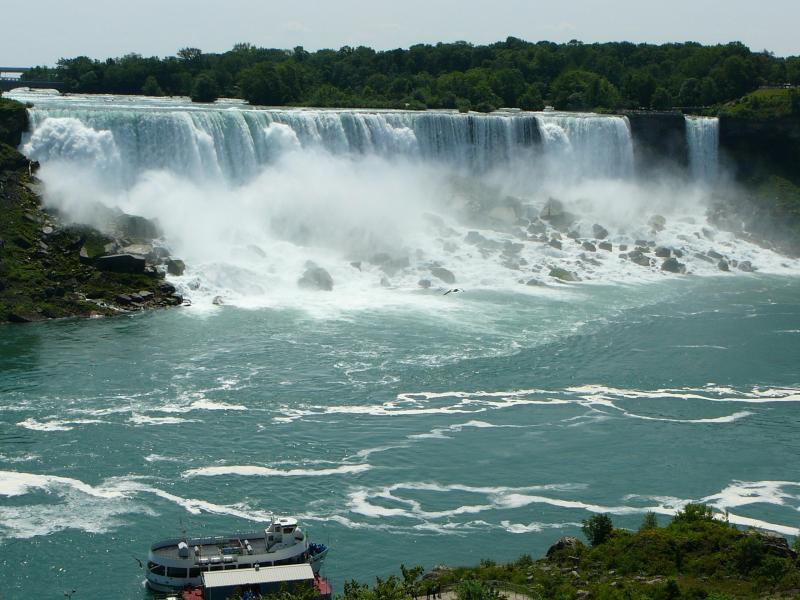
Niagara Falls isn’t the highest waterfall. But, for sheer size and volume of water, it can’t be beat. Four Great Lakes drain through the Niagara River and spill over Niagara Falls. The volume of water varies depending on the season and how much water is being diverted through power plants, but 700,000 gallons per second is not unusual for summer. |
|
There are actually three waterfalls at Niagara Falls, forming a giant arc across the Niagara gorge. The widest, at 2,200 feet, is Horseshoe Falls, forming the border between Canada and the US. Its plunge basin is deeper than the height of the waterfall you can view. In Niagara Reservation State Park, between Goat Island and Luna Island sits a narrow strand of falls called Bridal Veil Falls. Between Luna Island and mainland US is the 1,060-feet wide American Falls. |
|
|
|
It is hard to believe that such a simple thing as water, one of the most basic of elements, can create such a wonder and attract people from around the world. Niagara Fels has been visited by kings, queens, presidents, prime ministers, movie stars, the rich and the famous, and by millions of other people – all seeking a view of this water falling over a cliff. It is not water in itself, however, nor the height of its fall, that makes Niagara Falls so spectacular. Instead, it is the immense quantity of water. The only one water falls in the wourld, Victoria Falls in Africa, carries more water. The rain that falls in the drainage basin of the four upper Great Lakes, a vast geographic area encompassing a large fraction of the interior of North America, collects in the lakes and eventually funnels through the nohow Niagara River on its way to the Atlantic Ocean. Water that is now foaming over the Falls may have fallen years ago somewhere in the rugged wilderness of north-west Ontario, or on the dairy farms of Wisconsin, or the industrial cities of Illinois.
|
|
Niagara Falls Facts in numbers
Interesting Niagara Falls Facts Niagara Falls is not the biggest waterfall in the world, but the fact is that it is the famous. Niagara waterfalls face directly toward the Canadian shore. The most complete views of Niagara Falls are available from the Canadian shoreline, and it is the best spot for some amazing pictures. Niagara region is very rich in water, since it is surrounded by two lakes. Did you know that there are over 70 Niagara waterfalls, other than Horseshoe Falls, American Falls and Bridal Veil Falls? The original Niagara Falls was near the sites of present-day Queenston, Ontario, and Lewiston, New York, but erosion of the crest have caused the waterfalls to retreat several miles southward. At Grand Island, the Niagara River divides into the west channel, known as the Canadian or Chippawa Channel, and the east channel, known as the American or Tonawanda Channel. Water always flows down to the sea, and the land slopes downward through the Great Lakes Basin from west to east - but the Niagara River actually flows north. The brown foam below Niagara Falls is a natural result of tons of water plummeting into the depths below. The brown color is clay, which contains suspended particles of decayed vegetative matter. It is mostly from the shallow eastern basin of Lake Erie. The beautiful green color of the Niagara River comes from the dissolved salts and very finely ground rock. Estimated 60 tons of dissolved minerals are swept over Niagara Falls every minute. Amazing Niagara Falls Facts - Niagara Gorge
Provided info are not about Niagara waterfalls... there are some amazing facts in the neighborhood like Niagara Gorge and its famous whirlpool.
In the Whirlpool, you can see the reversal phenomena. When the Niagara River is at the full flow, the waters travel over the rapids and enter the pool, then travel counterclockwise around the pool past the natural outlet. Pressure builds up when the water tries to cut across itself to reach the outlet and this pressure forces the water under the incoming stream. The swirling waters create a vortex, or whirlpool. If the water flow is low (water is diverted for hydroelectric purposes) the reversal does not take place; the water merely moves clockwise through the pool and passes to the outlet. Below the Whirlpool is another set of rapids, which drops approximately 12 m. More amazing facts about Niagara Falls Did you hear about the Niagara Falls fact that the waterfalls dried up and frozen Niagara Falls?! In March, 1848 Niagara Falls had stopped. It lasted for thirty hours. The river dried up, and the fact is that millions of tons of ice became lodged at the source of the river, causing the channel to be completely blocked. From June to November, in 1969, the US Army Corps of Engineers completely blocked the flow of water over the American Falls. As they were doing some testing and surveys, the number of visitors significantly increased due to the rumors that Niagara Falls dried up.
Niagara Falls Facts - Weather: The coldest months in Niagara Falls are November through March with the average temperature between -6 and 4°C. April and October are also brisk. June, July and August are balmier, with average highs of 25°C and lows of 15°C. We hope that reading and being familiar with the above amazing and the most interesting Niagara Falls facts combining with your visit and experience will make your Niagara story incredible. |

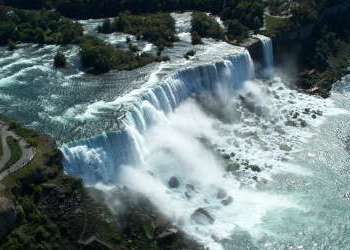
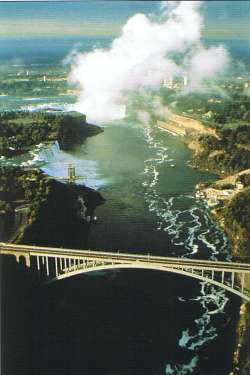
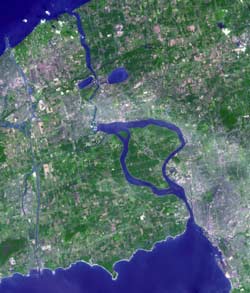 Niagara
River - Satellite
view
Niagara
River - Satellite
view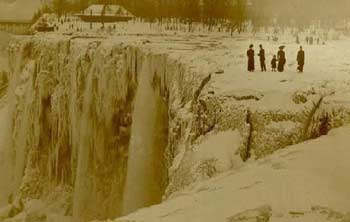 Frozen
Niagara Falls
Frozen
Niagara Falls